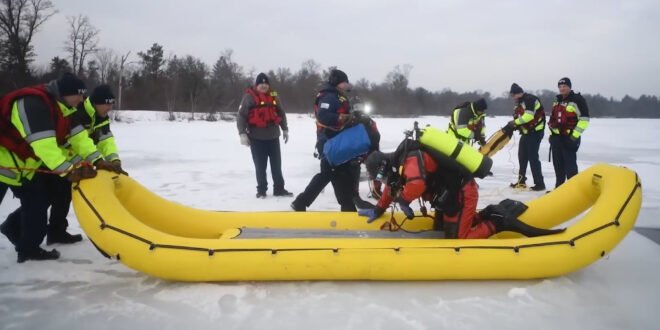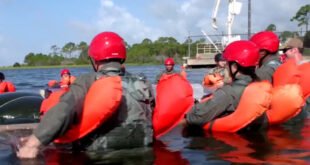The U.S. Navy’s well-known training program, ICE-X, or ice exercise, is intended to evaluate its submarine preparedness in polar locations. From their home port installations, submarines travel covertly for months before surfacing in these icy areas. In this blog, we are going to discuss the US Ingenious Method to Find Torpedoes Lost in Frozen Arctic Seas.
As they arrive, the group gets ready to settle into their makeshift encampment, where they will stay for a few weeks. Their job involves collecting information for research, launching and retrieving torpedoes using advanced methods, and receiving training to perform well in this challenging environment. Arctic diving is a critical component of ICE-X activities.
This crucial activity requires extremely skilled execution and training. Divers participating in arctic diving activities, often known as ice diving, must maneuver through dangerous circumstances and subfreezing temperatures. In order to guarantee the effectiveness and safety of both operations and divers during actual deployments, this training is essential.
Training for arctic diving involves intense teaching and methods unique to ice environments for participants. By using sophisticated equipment and communication systems to stay in contact with the surface, they learn how to safely move beneath large layers of ice. Divers are also prepared to deal with situations like equipment failures and abrupt changes in the surrounding environment.
Arctic diving also highlights the significance of resilience, both physical and mental. When stranded beneath dense ice sheets, virtually cut off from the surface, divers need to be ready and not lose heart. Recovering and refilling a torpedo after firing it in the Arctic adds a layer of complexity to the exercise.
Now, the task for the diving crew is to extract the weapon from under the ice. The operations team has already made a decision on their stance. Helicopters transport the equipment and divers to the anticipated destination, where they predict the torpedo will run out of fuel.
When they arrived, the staff erected improvised buildings that resembled ice fishing cabins and drilled a hole so the divers could enter and depart the freezing waters. Subsequently, the dive crew approaches the still torpedo and cautiously returns it to the entry hole. A helicopter then hoists the weapon out of the sea by tying it to a rope.
The Naval Undersea Warfare Center refuels the torpedo after it reaches land by taking out any leftover fuel or explosive material. By taking out any leftover fuel or explosive material, the Naval Undersea Warfare Center reduces risks and guarantees future safe handling. Beyond just being cold, ice presents many difficulties in both polar and habitat settings.
Since ice is naturally brittle, falling through it can pose a serious risk to anyone. Firefighters receive regular ice rescue training because they are aware of this risk and want to be ready for any emergency. Through these drills, participants get experience in risk assessment, safe ice navigation, and effective rescue techniques.
The rope technique is one of the methods firefighters employ to rescue people from ice. First, firefighters use a rope fastened to the stable ground around the ice to anchor themselves. Clad in ice rescue suits, boots, gloves, and helmets, they cautiously and methodically make their way across the ice to the person who is stuck.
Sliding reduces resistance on the ice and lessens the chance of breaking. Once there, they discover how to securely remove the sufferer from the hole using rope lines and return him to safety. The U.S. Coast Guard frequently uses inflatable ice skiffs as an additional means of extracting casualties from the ice.
This multipurpose gadget comes in extremely handy during ice rescue operations, especially if the person in need is unconscious. Rescuers can quickly reach the victim and get them to safety, thanks to the inflatable ice skiff. Alternatively, the U.S. Coast Guard can send out a Mars-SARS shuttle board if the person is aware.
They send this board and a rescuer who helps the victim get on board to the stranded person. The board provides a steady platform for the rescue, and the other rescuers pull it with ropes connected.
On the evening of October 25, 2020, the icy clutches of Alaska’s Taku River trapped three boatmen. The U.S. Coast Guard responded quickly to the distress call and arrived on the scene to save the boats that were stuck. It was a tough mission.
Five miles northeast of the Hole-in-the-Wall Glacier, the boat was stuck in about a foot of ice, with winds gusting to 23 miles per hour and a temperature of 31 degrees. Visibility was only about half a mile. The crew of the Coast Guard Air Station Sitka’s MH-60 Jayhawk helicopter faced formidable obstacles because of these conditions. Nevertheless, the Coast Guard team successfully lifted each stranded person from their boat, one at a time, using their experience.
The rescue crew evacuated the three boatmen to safety at Juneau Airport when they were all securely aboard the chopper. The Coast Guard mobilized its polar icebreakers for difficult rescue operations, including vessel rescue, in yet another amazing demonstration of its capabilities. On July 12, 2014, the Coast Guard Cutter Healy crew, a polar icebreaker, proved they were skilled at recovering vessels during a mission.
The Coast Guard moved quickly to assist with North Slope Borough Search and Rescue. After arriving at the spot, Healy’s crew expertly moved to free the boat from the ice, opening a clear path for it to travel.
Additionally, Cutter Healy was crucial in providing necessities to isolated regions. The escorting of the Russian tanker Rinda to deliver 1.3 million gallons of petroleum products to the town in western Alaska is one noteworthy example. In order to bring desperately needed petroleum to Nome, the project required cutting a route through 300 miles of ice that ranged in thickness from one to five feet.
Healy’s sturdy hull and powerful engines made it possible for Rinda to travel safely and resupply isolated locations with necessities. Cutter Healy is engaged in a variety of research projects and maritime security in the Arctic on a typical day. Healy has a strengthened hull and a powerful engine that allows it to break through four to five feet of ice at a speed of three knots. It can also function in frigid temperatures, down to -50 degrees Fahrenheit.
Up to 87 people can work aboard Healy, including up to 50 scientists. Healy offers the scientific community unique labs as the largest and most technologically advanced polar icebreaker in the United States. Scientists can find here any piece of equipment they could require for their investigations and studies.
The installation of modern equipment in the biochemical, electronics, meteorological, and photography laboratories supports scientific research. Scientists may undertake ground-breaking research in the arctic areas with unrivaled resources thanks to Cutter Healy’s facilities, which offer everything from investigating marine ecosystems to assessing atmospheric conditions. The crew uses equipment to gather data and samples from the subject studies, assisting scientists in their research.
Cutter Healy plays an important role in stability and research in the Arctic. The second U.S. Coast Guard icebreaker, Polar Star, is assigned to break ice in Antarctica while Healy is deployed to the Arctic. The only active heavy icebreaker in the United States, the Polar Star, was put into service in 1976 and can break ice up to 21 feet thick.
The crew keeps the ship available for the annual Operation Deep Freeze, during which they break ice in the Southern Hemisphere throughout the winter. After the operation is over, it heads back to the dry dock for essential repairs and maintenance before the next Operation Deep Freeze deployment. In order to reach the Antarctic region, the Polar Star must travel more than 26,350 miles. Once there, it must navigate 500 miles of densely packed ice in order to open channels that can be used to reach base stations.
Millions of pounds of fuel and cargo can be delivered as a result, giving replenishment ships safe passage. The purpose of the inspection is to verify compliance with the environmental protocol and the Antarctic Treaty.
This entails monitoring adherence to laws that forbid mining and military activity while encouraging ecologically friendly and safe station operations. The fact that American icebreakers are present in the polar areas shows how committed the country is to upholding international accords and encouraging scientific research in one of the most difficult and pristine settings on earth. ( View more posts )
 DailyDiscovery
DailyDiscovery





